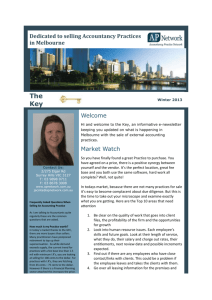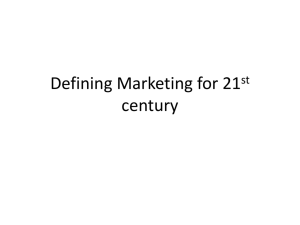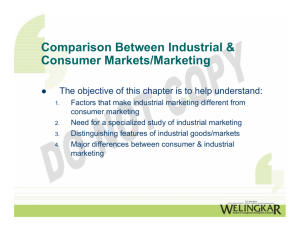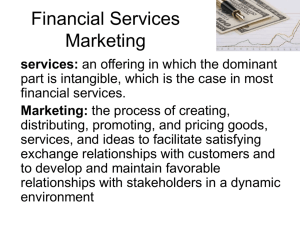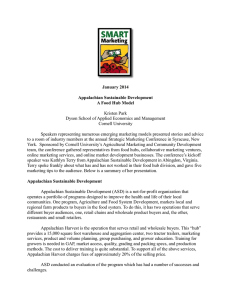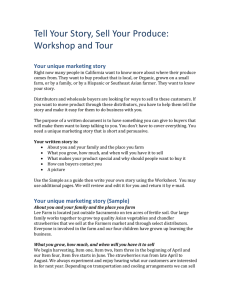understanding buyers + markets
advertisement
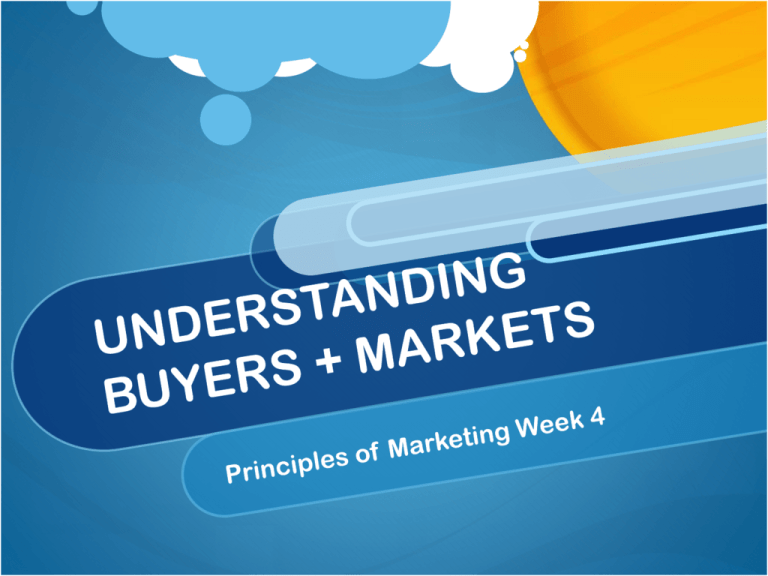
Learning Objectives The Market Defining the Market Understanding and Approaching the Market The Market is… Types of Markets Learning Objectives The Buyers Defining the Market Understanding and Approaching the Market The Market is… Types of Markets Defining the Market Impossible to define precisely, but we’ve discussed it’s definition as: A group of potential buyers with needs and wants and the purchasing power to satisfy them. Markets are people whether they are individuals or groups. Without people there would be no need to market Understanding and Approaching the Market People and organizations must meet certain basic criteria in order to represent a valid market Must be a true need or want for the product, service idea that can be recognized or latent Must have the ability to pay for the product Much have the authority to buy the product Those that meet the criteria must be large enough to be profitable for the marketer Understanding and Approaching the Market All five previous criteria must be met to equate a market. Failure to meet even one may negate the visibility of a market Look at the pharmaceutical industry Why do some diseases remain uncured? The Market is a Place Thinking of the market as a place “the marketplace” is a common practice of the general public. Such locations do exist as geographical areas within which trading occurs. In this context we can think of world markets, international markets, American markets, regions, states, cities, and parts of cities. A shopping center, a block, a portion of a block and even the site of a single retail store can be called a market. The Market is a Place Most times marketers try to define the people of a marketplace. However, the place description of a market is important as well. Goods must be delivered to customers attracted towards particular places where transactions are made The identification of markets is useful for market decision making purposes. The Market is a Place Factors such as the following are all affected by the geographic market. Product features Price Location of facilities Routing salespeople Promotional design A market might be somewhere other than a geographic region, such as a catalogues or ad that allows you to place an order The Market is an Economic Entity A market is characterized by a dynamic system of economic forces. The 4 biggest economic forces are: Supply, Demand, Competition, and Government Intervention. Terms Buyer’s and Seller’s market describe different conditions of bargaining strength The Market is an Economic Entity Placing labels on markets allows us to design strategies that match a particular economic situation. Buyer’s market, abundance of product, prices are low, and customers dictate the terms of the sale. The interactions of these economic factors is what creates a market. Type of Markets Now that we have defined markets in a general sense, it is useful to discuss the characteristics of the primary types of markets: Consumer markets Industrial markers Institutional markets Reseller markets Type of Markets Consumer Markets Include those individuals and households who buy and consume goods and services for their own personal use. Not interested in reselling the product or setting themselves up as a manufacturer. There are thousands of new products, services and ideas being introduced each day The increased capability of consumers to both afford these products, the size and complexity and future growth potential of the consumer market is staggering. Type of Markets Industrial Markets Include organizations and the people who work for them, those who buy products or services for use in their own businesses or to make other products. These type of markets function differently than do consumer markets and the buying process in particular different. Type of Markets Institutional Markets Includes various types of profit and non-profit institutions such as, hospitals, schools, govt agencies, and churches Differ from the typical business in that they are not primarily motivated by profits or market share. Tend to fulfill more intangible needs. Whatever profits exist after all expenses are paid are put back into the institution. The set of controls and restrictions means marketers must use different strategies to be successful. Type of Markets Reseller Markets All intermediaries that buy finished or semifinished products and resell them for profit are part of this market. Operate under unique business characteristics Producers are cognizant of the fact that successful marketing to resellers is just as important as successful marketing to consumers Buyers What is a Buyer? A predetermined group or individual who fits the target market, and that is either already an existing customer of a product or service and/or a person who the marketer hopes will become a customer. Buyers Understanding buyers has been, in the past, a more simple process. With the introduction of the internet, particularly social media, buyer behavior is more difficult to understand The relationship between business and buyers is undergoing the most significant transformation in decades. Continually redefines our knowledge of how buyers make decisions. Buyers Understanding buyers has been, in the past, a more simple process. With the introduction of the internet, particularly social media, buyer behavior is more difficult to understand The relationship between business and buyers is undergoing the most significant transformation in decades. Continually redefines our knowledge of how buyers make decisions. CONCLUSION Topics we have covered: The Marketing Concept Marketing Research Process Strategic Marketing and Market Characteristics Understanding Buyers and Markets CONCLUSION Each of these elements is building towards the final project which encompasses all the parts of the marketing plan. CLASS PRESENTATIONS

